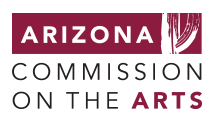New data released on March 25, 2024, show arts and cultural industries hit an all-time high in 2022, contributing 4.3% of gross domestic product (GDP), or $1.1 trillion, to the U.S. economy. Arizona’s arts & culture sector added a staggering $14.2 billion in value to the state’s economy, a 16.6% increase over 2021!
These findings and more come from the Arts and Cultural Production Satellite Account (ACPSA), a product of the National Endowment for the Arts (NEA) and the Bureau of Economic Analysis (BEA) that tracks the annual economic value of arts and cultural production from 35 industries—including both commercial and nonprofit entities. A national summary report and an accompanying interactive graphic are available on the NEA’s website, along with state-level estimates.
Arts and Cultural Industries as an Overall Sector
The overall arts economy grew by 4.8 percent in inflation-adjusted dollars between 2021 and 2022, a rate increase far surpassing that for the entire U.S. economy during the same time period. Since the pre-pandemic year of 2019, arts and cultural industries have surged by 13.6 percent. By contrast, the U.S. economy grew by 5.5 percent over the same period.
Top Arts and Cultural Industries
The top five industries by total value added to the U.S. economy in 2022 were: web publishing and streaming, broadcasting, government services (including public schools), publishing, and motion picture and video industries. The largest arts and cultural industry in the U.S., web publishing and streaming services, grew 40.9 percent in value added to GDP since 2019. Yet, from 2021 to 2022, this industry declined for the first time in recent history (by 1.4 percent).
In terms of percent growth in value added, in 2022, 25 out of 35 arts industries posted amounts exceeding 2019 levels, including agents and managers, sound recording, computer systems design, web publishing and streaming, and interior design services.
Arts and Cultural Industries that Declined in Economic Value
Six arts and cultural industries saw substantial declines—custom architectural woodwork and metalwork manufacturing, arts-related construction, printed goods manufacturing, photography and photo-finishing services, rental and leasing, and theatrical ticket agencies. Each of these industries showed a more than 10 percent decline in its economic value from 2019 through 2022.
Recovery of Performing Arts-Related Industries
The value added by three industries—independent artists, writers, and performers; performing arts presenters; and agents/managers—have all outstripped 2019 levels. (For example, the value added by independent artists, writers, and performers has jumped by 13.5 percent since 2019, with 18.4 percent growth between 2021 and 2022.) Performing arts organizations saw a steep decline in value added between 2020 and 2021. Between 2021 and 2022, however, the industry made a sharp comeback (an increase of 76.5 percent). Despite this rise, the value added by performing arts organizations is still below the pre-pandemic (2019) level. Note: the arts and cultural industries tracked in this account include both commercial and nonprofit entities.
Arts and Cultural Employment
In 2022, total arts and cultural employment recovered to pre-pandemic levels, with nearly 5.2 million workers employed to produce arts and cultural goods and services, for $540.9 billion in total compensation. (Note: ACPSA does not count self-employed artists and other cultural workers in its employment figures.) The top arts industries for employment include government services, arts retail, motion picture and video industries, broadcasting, and web publishing and streaming. Most arts industries (30 out of 35) saw gains in employment from 2021 to 2022. Overall, nearly half of all arts industries (17 out of 35) had higher employment levels in 2022 than in the pre-pandemic year of 2019.
Arts and Cultural Imports and Exports
From 2021 through 2022, arts and cultural exports continued to increase; the trade surplus rose from $15.5 billion to $21.0 billion. Top imports in 2022 included jewelry and silverware, audio/visual production services for TV and movies, and other manufactured goods such as glass and china. Top arts export commodities included creative advertising, information services such as audio/visual production for TV and movies, and arts-related software publishing.
State Economic Data on Arts and Cultural Industries
Between 2021 and 2022, every state and the District of Columbia saw growth in value added to their economies from arts and cultural industries, with 21 states showing increases of 10 percent or greater, when not adjusting for inflation. The added economic value from arts and culture surpassed 2019 levels for every state and DC. In terms of employment, although 45 states and DC have seen stable or growing arts and cultural employment from 2021 to 2022, only 20 states have reached or surpassed their 2019 levels.
For information on specific states, BEA has available Arts and Cultural Production Satellite Account fact sheets for each state. In addition, the National Assembly of State Arts Agencies (NASAA), in partnership with the NEA, has created an interactive dashboard with information on value added to state economies through arts and cultural production, as well as employment and compensation figures for the creative workforce.
Using the Arts and Cultural Production Satellite Account Data
On April 2, 2024, the NEA will launch a new suite of research-and-data tools as part of its National Arts Statistics and Evidence-based Reporting Center (NASERC). One resource, the Arts Indicators Project, will highlight key developments and trends across four domains, including arts and cultural assets, and will reference the ACPSA along with other data sources. More information will be available in a webinar on April 2, “Monitoring the U.S. Arts Ecosystem” that will explore the importance of public data in the arts. Participants will include NEA Chair Jackson and Vipin Arora, director of the Bureau of Economic Analysis, among others. Visit arts.gov for additional details and to register.
Recently, NASAA also released a new research report, Arts and Creativity Drive Economies and Build Resilience, on “the arts and culture sector’s contributions to economic recovery” that examined 2001-2021 ACPSA data. NEA Director of Research and Analysis Sunil Iyengar explored these findings in the recent article on the NEA’s blog: “Can the Arts Fortify State Economies in Times of Financial Crisis? Yes, Apparently.”
Value Added
Employment
Compensation
Comparing Arizona to Neighboring States
| State | Value added to state’s economy | Value added as a share of state’s economy | Employment in the arts | Arts worker compensation |
| Arizona | $14.2 Billion | 3% | 84,479 | $7.1 Billion |
| Colorado | $18 Billion | 3.68% | 104,163 | $10.1 Billion |
| Nevada | $10.9 Billion | 4.9% | 43,254 | $3.9 Billion |
| New Mexico | $3.4 Billion | 2.7% | 26,215 | $1.9 Billion |
| Utah | $8.5 Billion | 3.3% | 67,768 | $4.6 Billion |



